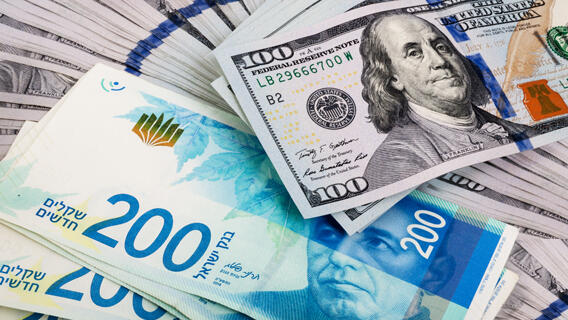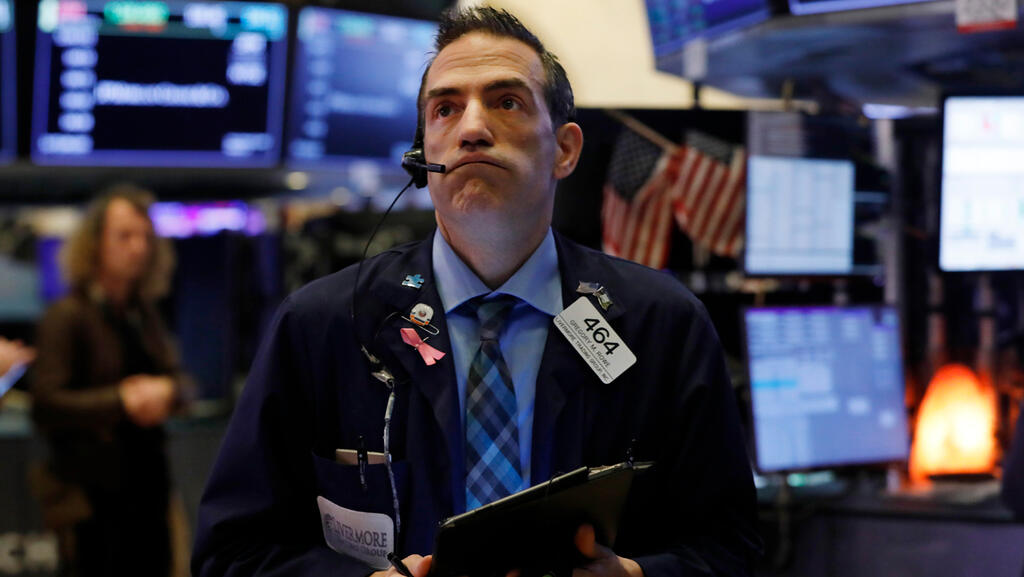After weeks of Israel's shekel growing weaker against the U.S. dollar and euro, a slight boost has been recorded, with an approximate 2.5%-3% increase taking place last week.
Other stories:
As of now, the dollar is trading at around 3.58 shekels and the euro at around 3.848 shekels, compared to just a week ago when the two were traded at around 3.75 shekels and over 4 shekels, respectively.
Changes in the shekel exchange rate have significant implications for the Israeli economy, with the most immediate and relevant impact being on inflation and the prices of the products we buy or sell. But what causes the shekel to strengthen or weaken? When does foreign exchange trade actually occur, and why is it slightly different from other investment assets, such as stocks?
Against the backdrop of the frequent changes in recent weeks and months, Ynet is shedding light on some of the most important terms in the local foreign exchange market.
What is the foreign exchange market?
The global currency market, or the foreign exchange (forex) market, is the largest financial market in the world. The average daily trading volume in the forex market is estimated to be over $5 trillion, which is several times greater than the total trading volume of stocks across all exchanges in the United States combined. The forex market operates 24 hours a day, from Sunday night to Friday night. Therefore, the extensive trading hours allow traders to react almost immediately to various developments around the world.
Since the early 1990s, supervision of foreign exchange in Israel has been gradually lifted, and today the shekel exchange rate is determined based on fluctuations in the free market in relation to other currencies. However, at times, the Bank of Israel intervenes in the market and buys or sells foreign currency itself. Additionally, on every business day, the central bank publishes representative exchange rates of the shekel against foreign currencies, which are based on market rates at the time of their determination. However, the representative rate is an indicator of the economic situation and does not uphold legal status. Therefore, in many cases, foreign exchange transactions are conducted based on the continuous exchange rate, which is more up-to-date and fluctuates throughout the trading day.
Who are the participants in the foreign exchange market?
Foreign exchange trading serves two main purposes: foreign trade and investment transactions aimed at generating profit. This is conducted primarily between banks and their clients in Israel and abroad, as well as between banks themselves.
Due to the complexity of the foreign exchange market, which often requires significant capital to trade and generate substantial profits, a large portion of the market's volatility is attributed to the activities of institutional entities such as banks, investment firms and government bodies.
However, almost every individual is somehow affected by fluctuations in the foreign exchange market in some way or another, even if they are not directly involved in currency trading. This can be through investment portfolios, pension funds or the impact of currency fluctuations on the prices of products we purchase locally and globally.
Why is the foreign exchange market different from other markets?
In most other markets, such as the stock market or commodities market, transactions occur between a seller of a specific product and a buyer who typically pays money to acquire that product. However, in the foreign exchange market, the commodity itself is the currency, and every buyer of a certain currency is a seller of another currency. Therefore, a significant portion of foreign exchange trading takes place not on exchanges (although that exists too) but directly between major banks worldwide.
When a bank's client wants to buy a specific currency, the bank offers them a valid exchange rate for that point in time, and the client must decide whether to proceed with the transaction or not. The transaction takes place between the bank and the client, and the bank's profit mainly comes from the sums of the differences between the rate it offers to the client and the rate it obtains for that currency in interbank trading. These sums are measured in a unit called "pips" (Percentage in point), which represents the fifth decimal place of the exchange rate (0.0001). For example, if the bank sells one dollar for 3.5000 shekels and pays 3.4700 shekels for that same dollar, the bank earns 300 pips (multiplied by the number of dollars purchased by the client) for that transaction.
Additionally, it should be noted that, alongside the conversion profit offered by banks to their clients, many banks in Israel also charge a trading fee for each foreign exchange transaction, which is separate from the conversion profit and provides additional income for the bank.
What are currency devaluations and revaluations?
Currency devaluation refers to a decrease in the value of a currency relative to other currencies. For example, when the dollar strengthens against the shekel and its exchange rate rises, meaning that more shekels are required to purchase each dollar, it implies a devaluation of the shekel. For instance, in the past year, the dollar exchange rate has increased by almost 6%, from 3.39 shekels to around 3.59 shekels today. This means that for each traded dollar, an additional 0.2 shekels must be paid.
On the other hand, currency revaluation is the opposite phenomenon, where the currency's exchange rate increases, as happened to the shekel last week. In such a case, the dollar's exchange rate (or any other currency for that matter) decreases, requiring fewer shekels to purchase each dollar.
What are the main factors causing recent fluctuations in the shekel?
In general, reasons for a currency's devaluations or revaluations in a free market are related to the buying or selling of that currency. If there is a high selling volume of a currency, its value decreases, whereas if there is a high buying volume, its value increases, accordingly.
In recent years, fluctuations in the shekel exchange rate have almost always correlated with trends in other leading Western markets, with an emphasis on the American market. However, in recent months, this trend has changed, and it is noticeable that the shekel is not influenced by global trends as much as it is affected by local trends, particularly concerns surrounding the judicial reform and its impact on Israel's economy.
3 View gallery


Yariv Levin and Benjamin Netanyahu are ready to move forward with judicial reform
(Photo: Shalev Shalom)
Therefore, with the acceleration of the legislation and the rise of social protests in Israel, along with the massive protests that have been taking place throughout the country for the past 25 weeks, the shekel has significantly weakened against the world's leading currencies, especially the euro and the dollar. However, when statements suggesting progress in negotiations between the parties are published, such as the recent statement by Justice Minister Yariv Levin in which he claimed that he does not care who will be elected to the current committee for selecting judges, the shekel strengthens again.
However, it should be emphasized that, as is the case in most financial markets, the immediate cause of these changes is not known with absolute certainty. In fact, many argue that some of the sharp fluctuations of the past week can be attributed to speculative activities by actors attempting to profit from the depreciation/appreciation of the shekel, rather than being a direct result of political developments in the country.
What is the connection to inflation and interest rates?
The connection between fluctuations in the shekel exchange rate and inflation and interest rates is a direct one. When the shekel significantly weakens, it can deepen inflation in Israel and contribute to price increases. For example, an importer of electrical products who previously paid $1,000 for a television, which had an equivalent value of about 3,400 shekels a year ago, would now pay around 3,600 shekels for the same television. Consequently, this increase is typically reflected in the final price for the consumer.
This also affects interest rates in the local economy, which are determined by the central bank. The central bank's goal is to stabilize prices in the local market and prevent a situation of inflation above the target range, currently set at 1%-3%.



